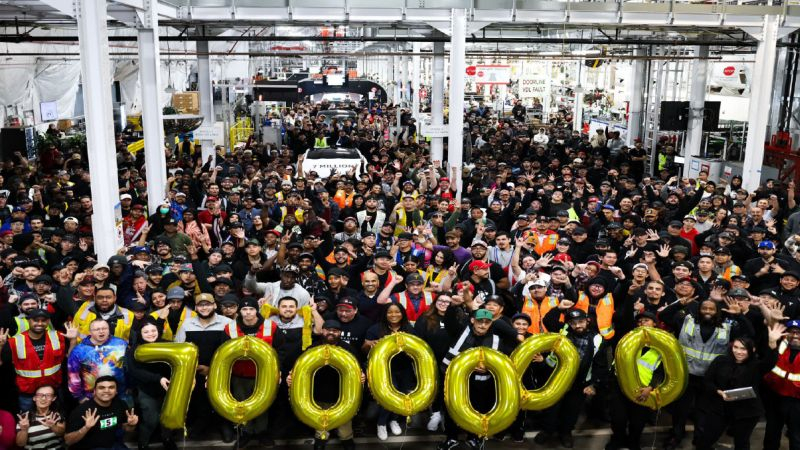Analysts associated rather contradictory expectations with Tesla’s quarterly reporting event that took place the day before, but the company’s management considered it possible to mention several records achieved during the period. First of all, a season-high number of electric vehicles were delivered in the third quarter, and a total of 7 million units have been produced in the company’s history. Secondly, the average cost of a Tesla electric car has dropped to a record low of $35,100.

Image Source: Tesla
In terms of revenue dynamics, Tesla slightly disappointed investors, as it increased it by 8% to $25.18 billion, while analysts expected $25.37 billion. Net profit year-on-year increased by 17% to $2.17 billion, exceeding analysts’ expectations , and the profit margin generally jumped to 19.8%. However, in the latter case, it is important to understand that Tesla received the second largest income in the company’s history from the sale of so-called regulatory loans. It accepts money from other automakers who fail to achieve the level of carbon reduction required by US law, and contributes to the fight for the environment indirectly in the form of money. Last quarter, Tesla received $739 million on this basis.
Looking specifically at Tesla’s electric vehicle revenue, it grew only 2% to $20 billion, and hasn’t grown much since the end of 2022. This did not stop the company from increasing production volumes of electric vehicles by 9% to a record 469,796 units. Moreover, Elon Musk at the reporting conference expressed confidence that at the end of the entire current year the company will be able to slightly exceed last year’s volumes of deliveries of electric vehicles (1.8 million units). To do this, Tesla will have to ship more than 506,000 electric vehicles based on the results of the fourth quarter. Musk also expects that next year the volume of production of cars of this brand will increase by 20 or 30% and will approach the cherished milestone of 3 million cars produced per year, due to the transition to a cheaper “intermediate platform” in production.
Tesla released its seven millionth electric car on October 22. This month, Tesla’s Chinese factory in Shanghai also produced its 3 millionth electric vehicle, and in September it exported its millionth electric vehicle. Tesla management spoke sparingly about the production of Cybertruck pickups, noting only the consistent growth in production volumes and the model reaching break-even, as well as the pickup becoming the third most popular electric vehicle in the US market after Model Y and Model 3, respectively. Tesla combines statistics on pickup trucks with Model S and Model X; together in the third quarter they increased production volumes by 91% year-on-year to 26,128 units. At the same time, sales volumes of these models increased by only 43% to 22,915 units. Sales volumes of Model 3 and Model Y also lag behind production volumes in terms of growth. While the latter increased by 6% over the year, the former grew by only 5%. In total, Tesla was able to ship 462,890 electric vehicles to customers in the third quarter, which is 6% more than last year. From this point of view, the results of the third quarter did not meet analysts’ expectations, and the two previous quarters were accompanied by a decrease in the volume of deliveries of Tesla electric vehicles in annual comparison.
Tesla announced that the cost of the brand’s average electric vehicle had reached a new historical low of $35,100. This was partly due to the dynamics of prices for raw materials and components, but the company is determined to continue lowering the costs of producing electric vehicles. This will be facilitated by the release to the market next year of modified Model 3 and Model Y, which will try on elements and technologies of the new platform, but will be able to be produced at existing enterprises. But by 2026, Tesla is still going to master the production of cars based on a promising inexpensive platform using new technology, but the first-born of the family will be the same robotic automatic taxi Cybercab.
Musk stressed that Tesla is committed to making all of its electric vehicles autonomous from a driving perspective, but not all cars with HW3 generation equipment will be able to achieve this without a hardware update. Already, the company produces about 35,000 cars a week, technically ready for independent movement on the roads. On the streets of California and Texas, unmanned Tesla electric vehicles in taxi services will appear next year, even before the release of Cybercab, and company employees will begin to take part in testing them as passengers before the end of this year. At first, there will be an insuring driver behind the wheel of such cars.
By launching Cybercab production in 2026, Tesla hopes to eventually increase its annual production volume to 2 million units. By the second quarter of next year, according to Musk, the safety level of the FSD complex will exceed the average accident-free level for drivers. Elon Musk’s predictably ambitious statements at the reporting event were enough to raise the company’s stock price by 12% after the close of the main trading session.